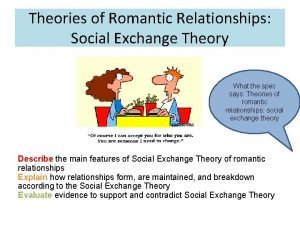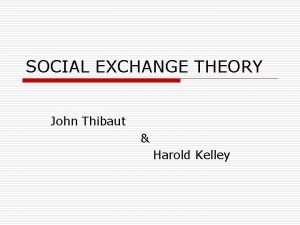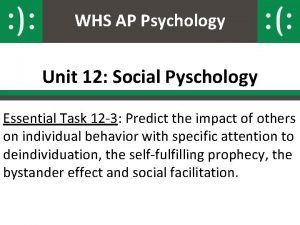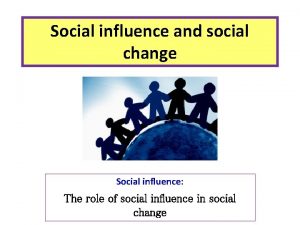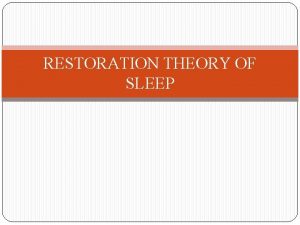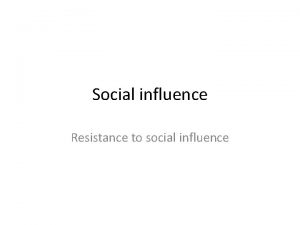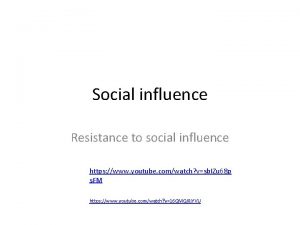Social Influence Social Exchange Theory This theory suggests




























- Slides: 28

Social Influence

Social Exchange Theory This theory suggests that social interactions are motivated by the desire to maximise ‘profits’ for self and minimise ‘losses’. This involves ‘give and take’ which should balance over time. Can you think of any examples?

Reciprocity Principle Refers to a type of social interaction that involves interacting or ‘repaying’ on the basic of what has been given. Examples: • An eye or an eye (revenge) • “I’ll scratch your back if you scratch mine”

Altruism Behaviour that is intended to be useful to others without any intention of personal gain or reward. Specific kind of prosocial behaviour where the motive to help is totally selfless. Tip: Focus on the act of “selflessness” to differentiate between ordinary helping behaviours and altruism. Example: Comforting your younger sibling after they fall over.

Activity Apply the correct theory to each example. Provide reasoning for your answers. 1. Offering to put out an elderly neighbours rubbish. 2. Volunteering to help run the school canteen. 3. Tutoring for money. 4. Moving a tree branch that has fallen onto the road on the street you are trying to drive down. 5. When someone smiles at you and you smile back.

Activity Apply the correct theory to each example. Provide reasoning for your answers. 1. Offering to put out an elderly neighbours rubbish. Altruism because the act does not benefit you in any way.

Activity Apply the correct theory to each example. Provide reasoning for your answers. 2. Volunteering to help run the school canteen. Altruism because the act does not benefit you in any way.

Activity Apply the correct theory to each example. Provide reasoning for your answers. 3. Tutoring for money. Social Exchange Theory because you are receiving money for your actions.

Activity Apply the correct theory to each example. Provide reasoning for your answers. 4. Moving a tree branch that has fallen onto the road on the street you are trying to drive down. Social Exchange Theory because the branch is blocking the road you need to drive on, you are performing this behaviour to benefit yourself first.

Activity Apply the correct theory to each example. Provide reasoning for your answers. 5. When someone smiles at you and you smile back. Reciprocity Principle because you are reciprocating or ‘repaying’ the behaviour in that social interaction.

Issues with the Altruism Theory By performing an act of helping behaviour a person experiences gratification; a pleasurable emotional reaction of happiness in response to a fulfilment of a desire or goal. This creates an issue with the altruism theory, as we begin to ask: “Is there such a thing as a ‘selfless’ good deed? ” https: //www. youtube. com/watch? v=Dow. Jf. Umlze. I

Factors Affecting Helping Behaviour Grouped into three main categories: 1. WHY people help 2. WHO people are more likely to help 3. WHEN helping behaviour is more likely to occur

WHY People Help • Evolutionary Theory • Cost-Benefit Analysis • Egoistic and Altruistic Motives • Social Norms

Evolutionary Theory People are motivated to help others who are closely related and therefore share many of the same genes because it is an investment in their genetic survival. It helps increase the proportion of their genes that is passed to the next generation. What are some examples of this?

Cost-Benefit Analysis In making a decision whether or not to help someone, people compare the ‘costs’ and ‘benefits’ of helping the other person. Based on social exchange theory (maximising ‘profits’).

Cost-Benefit Analysis Example: Seeing someone collapsed on the street and deciding what it will ‘cost’ and ‘benefit’ you from helping. Costs: Time, effort, fear of ‘stranger danger’ Benefits: Gratification from helping, save their life

Egoistic and Altruistic Motives Egoistic Motives (selfish): A bystander may help someone in distress because it relieves their own stress and anxiety. Altruistic motives (selfless): When a person actually helps someone without any thought for self. In pairs, decide two examples for each motive.

Empathy-Altruism Theory People are more likely to show help if they feel empathy towards the person in distress.

Empathy-Altruism Theory

Social Norms Socially based ‘rules’ about the way people behave that prescribe what someone should or should not do in particular social situations. What are some social norms you can think of? Grouped into two types: 1. Reciprocity Norm 2. Social Responsibility

Reciprocity Norm People help others because it is expected that other people will return the help. Based on reciprocity principle (‘repaying’ behaviour given).

Social Responsibility Norm People should help others who are dependent or in need of help without there being any expectation of the help being returned.

What type of social norm do our examples fit into? 1. Reciprocity Norm 2. Social Responsibility

WHOM People Help Gender: Research shows that a combination of the gender of the helper, the gender of the recipient and the particular situation determines whether help will be given or received. Helper Likelihood of victim receiving help Female Males and females equally likely Male Females more likely

WHOM People Help Males are more likely to help a female if she is alone and perceived to be in distress. Females are more likely to seek help than males. Why do you think this is?

WHOM People Help Similarities: People are more likely to help others if they are perceived to have certain things in common. For example: People who dress the same or hold the same attitudes.

WHOM People Help Think of two reasons to explain why similarities between the helper and the victim increase the likelihood of helping behaviour.

Homework: WHY Factors That Influence Helping Behaviours Factor Evolutionary Cost-Benefit Egoism Altruism Social Norms Explanation Important Variables Example
 Social thinking and social influence in psychology
Social thinking and social influence in psychology Social thinking social influence social relations
Social thinking social influence social relations Predictability vs novelty example
Predictability vs novelty example Government influence on exchange rates
Government influence on exchange rates Social thinking and social influence
Social thinking and social influence Social thinking theories
Social thinking theories Social influence theory of hypnosis
Social influence theory of hypnosis Social influence theory of hypnosis
Social influence theory of hypnosis Real exchange rate formula
Real exchange rate formula Pearl exchange activity
Pearl exchange activity Gas exchange key events in gas exchange
Gas exchange key events in gas exchange Richard emerson social exchange theory
Richard emerson social exchange theory Examples of social exchange theory
Examples of social exchange theory Aztia
Aztia Assembly theory
Assembly theory Superordinate goals psychology definition
Superordinate goals psychology definition Social exchange theory
Social exchange theory Onomatopoeia
Onomatopoeia In line 2 impatient of is best interpreted as meaning
In line 2 impatient of is best interpreted as meaning Tom's constant shoplifting suggests
Tom's constant shoplifting suggests Long shot framing
Long shot framing The efficient market hypothesis suggests that _______.
The efficient market hypothesis suggests that _______. Projective hypothesis psychology
Projective hypothesis psychology Whales have vestigial legs. this suggests they _____.
Whales have vestigial legs. this suggests they _____. Sour cream walls is an example of pun
Sour cream walls is an example of pun Whales have vestigial legs. this suggests they _____.
Whales have vestigial legs. this suggests they _____. As its name suggests
As its name suggests Stands for uprightness and cool headedness
Stands for uprightness and cool headedness Informational social influence psychology definition
Informational social influence psychology definition











